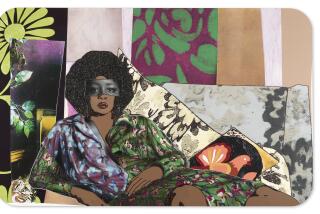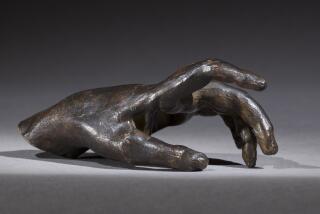Opening the Door for Women in Art History
SAN DIEGO — You might call Ilya Sandra Perlingieri one of the first Guerrilla Girls among Renaissance art historians. Like that band of anonymous, mostly New York women that has been trying to prod and shame the male-dominated contemporary art world into paying more attention to women artists, Perlingieri has a score to settle: Women have been left out of Renaissance art history. Among the hallowed names of Michelangelo, Titian and Holbein belongs another, she says: Sofonisba Anguissola.
“There’s a male bias that there couldn’t possibly be a woman painter as good as any male painter in the Renaissance, but her work speaks for itself,” Perlingieri said in a recent interview. “Anguissola was a link between Italian art and Spanish court portraiture, and a pioneer of genre painting. She was an extremely important figure.”
Perlingieri’s new book, “Sofonisba Anguissola: The First Great Woman Artist of the Renaissance,” released in June by Rizzoli and acclaimed in reviews in The Times and the New York Times, makes a strong case for Anguissola’s talents. Implicitly, it also argues for the existence of countless other accomplished women artists whose names have been erased by time or omitted by an ever-present male bias Perlingieri speaks of.
Her rediscovery of Anguissola (1532-1625) will be the subject of a free, public lecture on Wednesday night at San Diego State University, where she teaches in the Department of Women’s Studies.
In her mission to reclaim Anguissola’s status as an internationally known painter, Perlingieri faced odds nearly as discouraging as those encountered by the artist herself almost 500 years ago, when she sought to become a painter.
*
“Women didn’t have much status in the Renaissance,” Perlingieri said. “We think of the Renaissance as a period of rebirth, a period that opened up all sorts of avenues for men and women. The reality is that’s true only for men. Women were chattels first of their fathers, then their husbands.”
Anguissola’s aristocratic heritage afforded her certain opportunities, but disallowed others. She received a broader education than most women of her day, including training with a painter in her home town of Cremona, Italy, and later with the aging Michelangelo in Rome, but she never served a formal apprenticeship, as was expected of male artists.
When her skill and vision as a painter earned her an invitation to join the court of King Philip II in Madrid, where she worked for almost 20 years, she went as a lady-in-waiting to the queen, rather than as a court painter. Her status as a noblewoman had priority over her position as a court painter, Perlingieri explained. “That’s how she fell through the cracks--she went off to Spain as a lady-in-waiting.”
Dragging a fine-toothed comb through Spanish, Italian and British archives, Perlingieri gleaned enough solid nuggets of information to reconstruct the painter’s life. Because of Anguissola’s unusual history, references to her life were not easily found among other historical art documents of that period.
“There were no other women artists in the court. She was the first woman with this kind of international reputation. (Her contemporaries) didn’t know where to put her in the historical record, this extraordinary woman who broke through so many social conventions.”
*
The boldly talented Anguissola met her match in her own biographer. During the 16 years it took to research and write Anguissola’s life story, Perlingieri, who received her master’s degree in art history from San Diego State University, identified closely with her subject’s unconventional persistence. That affinity blossomed the moment Perlingieri first saw Anguissola’s work--a self-portrait hanging in the Los Angeles County Museum of Art in a landmark 1976 exhibition of women artists.
“Here was this woman looking out at me from 4 1/2 centuries, playing an instrument that was the forerunner to the piano, which I play. Art history was my major in undergraduate and graduate school and here was this woman I had never heard about, even in more esoteric journals of Renaissance art.”
Although art historians of the 17th Century regarded Anguissola with high respect, culminating in at least two biographies of the artist, more recent scholars have treated her with a neglect that Perlingieri sees as less than benign.
“Art historians have kept the story buried,” she said. “The few who have known about her life have not pursued this at all. It was not important enough, it didn’t matter. It mattered that we learned about the third and fourth and fifth-rate male artists, but not about the first-rate women.”
That conscious disregard for women artists loomed like an impenetrable brick wall when Perlingieri was studying art history in college, at New York University. Art historian H. W. Janson, author of art history’s most standard reference book in English--”the bible of art history” chaired the university’s art history department at the time. No women artists were mentioned in the early editions of his art historical survey.
“I remember an innocent comment I made to him: Where were the women? His comment to me was that they didn’t matter much. It burned in my memory.”
Even in graduate school at SDSU, when she began to focus on Anguissola, Perlingieri’s interest in women artists was rebuffed.
“With the exception of one professor, I was discouraged from the beginning. ‘Why bother?,’ they said. ‘Do work on Holbein, Durer, anybody but Sofonisba.’ It seemed to me there was a flaw in American graduate studies. You go to graduate school to break new ground, but here it was not the case. So it became a mission.”
Perlingieri reports proudly that more recent editions of Janson’s tome include Anguissola and other women, thanks, she says, to the pioneering research that she and other scholars have done. That brick wall of sexist condescension may be a bit more porous now, but it still stands. When Perlingieri teaches her course on women artists from the Renaissance to the present, for instance, it falls under the auspices of women’s studies, rather than being offered as part of the university’s art history curriculum.
“Art departments, with rare exceptions, are not as open as I would like to see to incorporating women into the mainstream. There’s still a tremendous amount of resistance in the field,” Perlingieri said.
When she looked for a publisher for her book, Perlingieri ran up against similar obstacles. One company agreed to publish it, but “without the women’s issues,” leading Perlingieri to conclude that, “We need to re-evaluate the way history has been taught.”
The discipline of art history has been more welcoming of a “revisionist” approach in recent years, one that incorporates social, economic and political histories into its study of art, but the male bias lingers on.
“What I would like to see, and what I strive for in my research and teaching is a balance in what we know about art history,” Perlingieri said. “Until the last 15 years, men have been writing the history books, the criticism and deciding who gets in, and that’s only half the population. We, as human beings, are thirsting to know the other half of the story.”
*
Perlingieri hopes to organize an international touring exhibition of Anguissola’s work, one that would expand our notion of Renaissance painting to include the human warmth and interaction that she sees as hallmarks of Anguissola’s art. Perlingieri’s book, which will also serve as a dissertation for the Ph.D. she is pursuing at UCLA, aims to broaden our view of Renaissance art as well and to make that view accessible to a wide audience, not just to scholars of art history.
Breaking down the entrenched models of history and replacing them with new, more equitable and humane ones is not an easy task, Perlingieri has discovered. But then, nothing is easy in life, she says.
“As my grandmother would say, if you reach for the stars and only get to the treetops, it’s better than reaching for a bush and getting there.”
Perlingieri’s free, public lecture on “Rediscovering a Renaissance Painter” will take place at 7:30 p.m. today in San Diego State University’s Montezuma Hall. A book signing will follow in Peiffer Lounge. Perlingieri will also be signing books from 10:30 a.m. until noon Thursday at In Harmony bookstore, 4808 Santa Monica Ave., Ocean Beach.
More to Read
The biggest entertainment stories
Get our big stories about Hollywood, film, television, music, arts, culture and more right in your inbox as soon as they publish.
You may occasionally receive promotional content from the Los Angeles Times.










